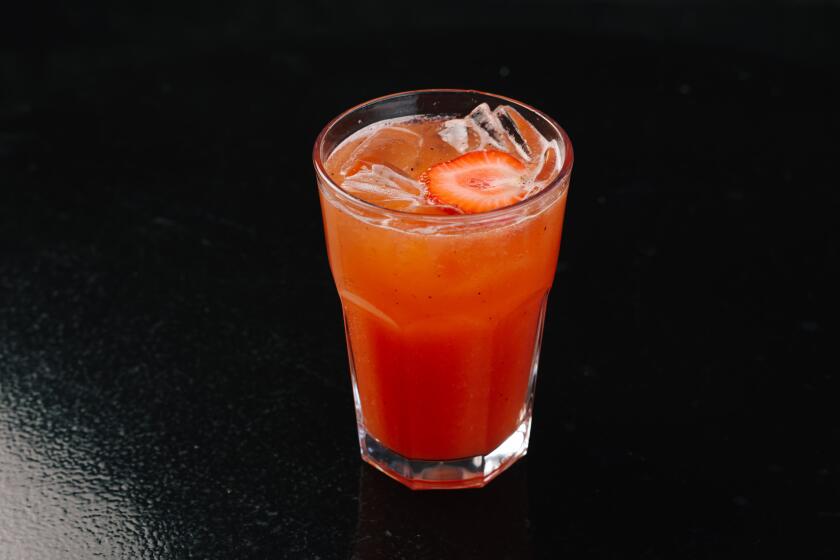Basic chicken stock

- Share via
Imagine a beautifully nuanced sauce built from a stock you’ve made in your own kitchen, coaxed from bones and aromatic vegetables and herbs. Imagine the slow pot, the beautiful machinery of a recipe, the way a dish can be assembled by degrees: stock from bone, sauce from stock, and from that sauce a dish to crown a perfectly realized meal.
Yet a sauce is only as good as the ingredients you use to make it. Which, for many sauces, means that your sauce is only as good as the stock that serves as its foundation. The French word for stock -- fond -- in fact means foundation.
True, making homemade stocks and glaces de viande, the name for the incredibly rich reductions made from meat stocks, is a serious investment of time. But the technique is simple, and it’s well worth the effort. Especially if you make a large batch now, while happily simmering stockpots are still in season.
Why make your own stock when you can easily buy it? Because canned stock is often laced with salt or additives, and even the best-quality frozen ones usually don’t have enough gelatin to distinguish them as really good stock. Because a pot of spectacular stock made on a slow weekend can fill your freezer and be a terrific timesaver later. And because making stock can be a soothing, contemplative experience, an occasion to consider the marriage of ingredients, fire and time.
There’s a reason making stock is the first thing they teach you at culinary school. So many of the dishes -- and sauces -- that become a cook’s signature depend on them.
The two most essential stocks in any kitchen are a basic chicken stock and a brown meat stock, traditionally made from veal bones. With these two, you can create a matrix of recipes -- soups, braises, and sauces -- that use the stocks as a basic building block.
Glace de viande, or more simply glace, is also extremely useful. It shouldn’t, however, be confused with demi-glace, which is a distinct sauce (a reduction of espagnole sauce with veal stock, plus some Madeira). True demi-glace is used less and less in professional kitchens, not only because making sauces-within-sauces is so time- and labor-intensive, but also because chefs now prefer the cleaner taste of simple reductions made without roux.
Glace is a kind of secret ingredient that you can pull out of the freezer to make a quick sauce diable or bordelaise -- two sauces that would otherwise take hours. Or simply add a nub of glace to a pan you’ve deglazed with wine or water for a terrific instant pan sauce.
Caramelizing the bones
But all this begins with a good stock. Start with the bones, which you can get from your butcher or, if you ask, many grocery store meat counters. For a brown stock like a veal or beef stock, the bones are first roasted in the oven so they caramelize.
Chicken stock is usually made without roasting the bones, for a subtler flavor. (You can, however, roast them if you want richer flavor.) For a classic stock, use a ratio of 5 pounds of bones to 1 pound of mirepoix (diced carrots, celery and onions) and 5 quarts of cold water.
For a veal stock, roast the bones first and then the mirepoix (so the vegetables, which cook more quickly, don’t burn). It’s important to roast both thoroughly: The more caramelized they are, the more flavor will be in your stock.
Put the roasted bones into a large stockpot, add cold water -- the cold is important for the proteins to coagulate evenly -- and slowly bring to a simmer. Once the vegetables are roasted, add some tomato paste and cook it for a few minutes on the stove top to caramelize, then add this to the stockpot too. Deglaze the vegetable-tomato paste pan with red wine and add the liquid to the stockpot, along with a bouquet garni and some peppercorns.
Bring the ingredients in the stockpot to a simmer; once the stock is simmering, lower the heat to maintain a bare simmer (make sure it doesn’t boil), and start skimming, as foamy-looking impurities rise to the surface. Skim until the liquid is pretty clear (being careful not to skim out the mirepoix). Cook at a bare simmer for about eight hours, skimming occasionally as needed.
For chicken stock, bring raw chicken bones and, if you can get them, chicken feet (which add flavor and increase the amount of gelatin), mirepoix and a bouquet garni plus cold water to a slow simmer, then simmer on very low heat for about four hours. Both the chicken and veal stocks can cook longer than these suggested times: up to six hours total for chicken; up to 48 hours for veal, though you’ll have to add more water.
Deeper flavor can be achieved this way, but such long cooking isn’t necessary for a good stock.
When you get the hang of the basic technique you can -- and should -- play with it. For chicken stock, throw in lemongrass, fresh ginger, cilantro, a handful of Thai chiles. For veal stock, add leek tops, garlic, a bouquet of celery tops, whatever herbs you find in your garden. Stocks are useful ways to use up vegetables that might be past their prime or leftovers from your freezer. Just make sure that you never treat your stockpot as a garbage bin -- and that you resist any urge to add salt.
When the stock is finished cooking, strain it and cool it as quickly as you reasonably can, ideally in a big ice bath in your sink. You want to make sure that the proteins cool quickly. Then refrigerate it.
When the stock is chilled, you can easily remove the layer of fat that’s risen to the surface. The stock will have the consistency of jello, from the gelatin in the bones. Divide it among smaller containers, and refrigerate or freeze it for use later.
At this point, you have some pretty amazing stock. You can reduce some or all of any meat stock to about a tenth of its volume to make a glace de viande. Simply cook it down over low heat until it’s rich and thick, the consistency of honey.
If you use brown veal stock to make a glace, a gorgeous bordelaise sauce is minutes, not hours, away. Reduce red wine with a few fresh herbs, add stock, a little Madeira to evoke the banished demi-glace, and reduce it a little further. Swirl in some glace, a nub of butter, a squeeze of lemon, some diced beef marrow (if desired), and you have a transcendent sauce for a grilled steak.
It’s a perfect marriage of economy and extravagance -- not unlike the stocks and glaces themselves.
Place the bones in a large (10-quart) stockpot. Make a bouquet garni by placing the parsley, thyme and bay leaf inside the leek halves and tying them with kitchen twine, leaving one end of the string about 24 inches long. Add the bouquet garni to the pot, tying the long end of the string to the pot. Add the onions, celery, carrots and peppercorns.
Add 5 quarts cold water and cook over high heat until the water comes to a simmer, about 30 minutes. Immediately reduce the heat to low so that the stock is barely simmering.
Simmer uncovered over low heat for about 4 hours, skimming the top to take off any scum and being careful not to let the stock boil. If it does, move the pan slightly to the side of the burner.
After 4 hours, strain the stock into a large pan through a large fine-mesh strainer. Put this pan in the sink, and fill the rest of the sink with ice cubes and cold water so the stock cools quickly. Once cool, cover and refrigerate.
When the stock is cold, remove and discard the layer of fat from the surface. Refrigerate or freeze the stock until needed.
Get our Cooking newsletter.
Your roundup of inspiring recipes and kitchen tricks.
You may occasionally receive promotional content from the Los Angeles Times.
















